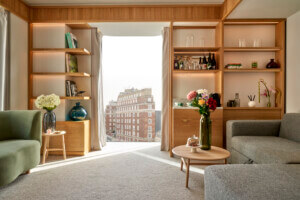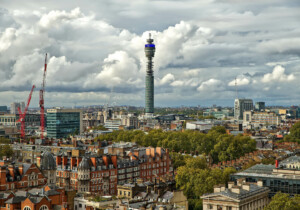“Utopia by Design” is the theme at this year’s inaugural London Design Biennial. On show at the three-week event are a series of installations from 37 countries, all located inside and around the grounds of Somerset House by the Thames. The show runs until September 27.
The Architect’s Newspaper was in attendance and we’ve collected some highlights below:
Mexico
The highlight of the Biennal, Border City was designed by Mexican architect Fernando Romero. Drawing on contemporary issues such as immigration, border control, and economic zoning, Romero’s masterplan coalesces employment, trade, and cultural dimensions into the “Border City.” Here, the three states of New Mexico and Texas (U.S.) and Chihuahua (Mexico) would join as one singular hub.
Romero makes use of a topographical circular map and projection screens that wrap around the exhibition space. The visually intense installation submerges the audience into a wealth of information including population growth data, demographics, consumption, and resources for the U.S., Mexico, and the world. Phrases like “special economic zones” outline where trade areas would be in Romero’s binational “Border City” as further projections take you through renderings of the fictional city.
Lebanon
Located on the riverside, Lebanon’s installation provides a taste of Beirut for Londoners. While kebab shops are nothing new in the capital, Annabel Karim Kassar’s work immerses audiences into a typical Beirut street scene offering kebabs, Lebanese coffee, and even a wet shave. While the smell of spices waft through the vicinity and local music fills the air, a breeze running off the Thames brings you back home. Lebanon’s piece won the London Design Biennale Medal 2016 for the most exceptional design contribution.
Chile
Inside, Chile’s “Counter Culture Room” offers an insight into the utopian dreams the country had under socialist President Allende of the 1970s and how they were very nearly realized. A short film relays how the country enlisted British cybernetics expert Stafford Beer for Project Cybersyn. Beer aimed to use cybernetics as a form of governance, whereby a central control room—one that could be mistaken for belonging to a 1970s sci-fi villain—would oversee the country. It was a cyber management system that would unite workers with the authorities through a flow of information. Though these plans never made it off the ground due to Pinochet’s coup, Chilean studio Fab Lab Santiago made four chairs slicing a would-be control room in two. Interesting though the backstory is, visitors can’t feel empowered as the chairs are sadly unavailable for sitting in.
Austria
Austria’s installation symbolizes the fragility of utopias. The kinetic light sculpture comprises a complex arrangement of interconnected earbud-shaped lights. When left still, the whole structure is fully illuminated, however, when moved in any way, lights close to the source of movement dim and turn off. A slight nudge can rupture the delicate ambience that exists, meaning lights out in utopia.










